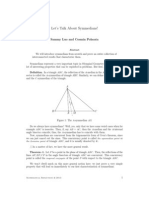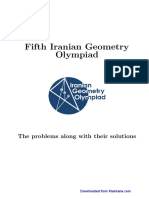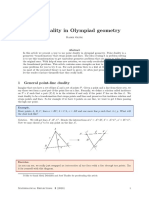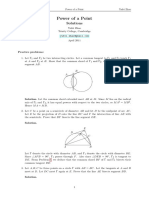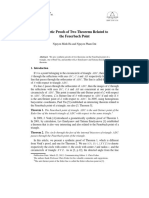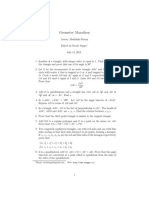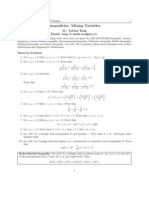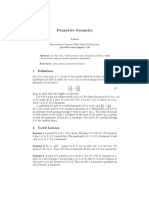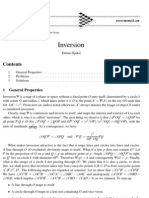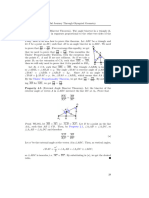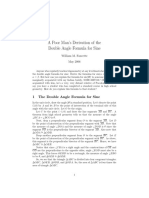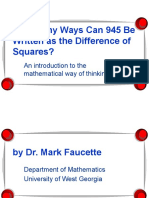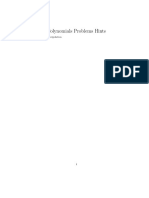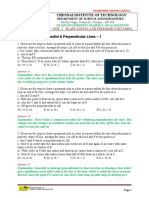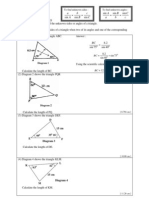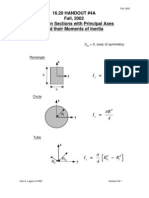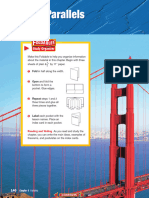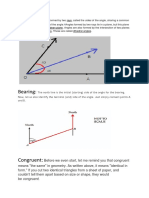TJUSAMO 2013-2014 Symmedians
TJUSAMO 2013-2014 Symmedians
Uploaded by
Chanthana ChongchareonCopyright:
Available Formats
TJUSAMO 2013-2014 Symmedians
TJUSAMO 2013-2014 Symmedians
Uploaded by
Chanthana ChongchareonOriginal Description:
Copyright
Available Formats
Share this document
Did you find this document useful?
Is this content inappropriate?
Copyright:
Available Formats
TJUSAMO 2013-2014 Symmedians
TJUSAMO 2013-2014 Symmedians
Uploaded by
Chanthana ChongchareonCopyright:
Available Formats
TJUSAMO 2013-2014
Symmedians
Robin Park
Symmedians
Robin Park
January 13, 2014
This solution is unnecessarily synthetic.
-Victor Wang, MOP 2013
Symmedians are three lines uniquely determined by a triangle. It has various properties that assist in solving
Olympiad geometry problems.
Properties
Definition. The A-symmedian of 4ABC is defined as the reflection of the median from A over the angle
bisector from A.
A
Like the medians, angle bisectors, altitudes, and perpendicular bisectors, the symmedians of a triangle concur
at a point:
Theorem 1. The A-, B-, and C-symmedians of 4ABC concur.
A
Proof. Trig Ceva implies that the concurrency of the symmedians is equivalent to the concurrency of the
medians, which is true.
TJUSAMO 2013-2014
Symmedians
Robin Park
This point of concurrency is called the symmedian point (sometimes the Lemoine point) K. In fact, the
existence of the symmedian point is a special case of the existence of the isogonal conjugate of a point; in a
triangle, its symmedian point is the isogonal conjugate of its centroid.
The following property of the symmedian is widely known, and is usually called the symmedian lemma.
Lemma 2. Let ABC be a triangle, and let P be the intersection of the tangents to the circumcircle of
4ABC at B and C. Then AP is the A-symmedian of 4ABC.
A
C
E
Proof. Let be the circle centered at P with radius P B. This circle passes through C because P B = P C.
Now let D and E be the intersections of with AB and AC, respectively. Finally, let M be the midpoint
of segment BC and O the circumcenter of 4ABC.
Note that
DBE = BAE + AEB
= BAC + CEB
1
= (BOC + CP B) = 90 .
2
Hence DE is a diameter of , and so P is the midpoint of segment DE. Observe that 4ABC 4AED,
and so 4AM C 4AP D. Thus CAM = DAP = BAP , implying that AP is the A-symmedian.
The next lemma provides a nice ratio relationship between the distances from X to B and C:
Lemma 3. Let X be a point on BC such that AX is the A-symmedian of 4ABC. Then
AB 2
BX
=
.
CX
AC 2
Proof. Note that
sin BAX
sin AXB
sin CAX
sin AXC
=
and
=
.
BX
AB
CX
AC
2
TJUSAMO 2013-2014
Symmedians
Robin Park
Dividing these two gives us
BX
AB sin BAX sin AXC
AB sin BAX
AB 2
=
=
=
CX
AC sin AXB sin CAX
AC sin CAX
AC 2
as desired.
Another interesting property of the symmedian is that it is the locus of the midpoints of antiparallels. We
say that two lines/segments `1 and `2 are antiparallel with respect to an angle if the angle formed by `1 with
one side of the angle is equal to the angle formed by `2 with the other side.
A
Q
`1
`2
In the diagram above, AQP = ABC and AP Q = ACB. Notice that this immediately implies that
BCQP is cyclic, since ABC + P QC = AQP + P QC = 180 .
Lemma 4. The A-symmedian of 4ABC is the locus of the midpoints of the antiparallels to BC with respect
to BAC.
A
M
P
B
Proof. Let P and Q be points on AB and AC such that P Q is antiparallel to BC, and let M be the midpoint
of segment P Q. Let X be the intersection of AM and BC. By the Generalized Angle Bisector Theorem,
1=
Hence
MP
AP sin M AP
=
.
MQ
AQ sin M AQ
AB sin XAB
AB sin M AP
AB AQ
AB 2
BX
=
=
=
=
CX
AC sin XAC
AC sin M AQ
AC AP
AC 2
and so by Lemma 3, AX is the A-symmedian.
TJUSAMO 2013-2014
Symmedians
Robin Park
The Lemoine Circles
There are two circles that correspond to the symmedian point of a triangle:
Theorem 5 (First Lemoine Circle). Let K be the symmedian point of triangle ABC. Prove that the six
intersections formed by the three parallels with respect to the sides of 4ABC passing through K and the
sides themselves lie on a circle.
A
P3
Q3
P1
Q2
P2
Q1
Proof. Let P1 , Q3 ; P2 , Q1 ; and P3 , Q2 be points on AB, BC, and CA, respectively, such that P1 Q2 k BC,
P2 Q3 k CA, and P3 Q1 k AB.
Notice that AP3 KQ3 is a parallelogram, so the midpoint of P3 Q3 lies on AK. However, AK is the Asymmedian of 4ABC, implying that P3 Q3 is antiparallel to BC. Therefore, AP3 Q3 = ABC = Q3 P1 Q2
and so P1 Q2 P3 Q3 is cyclic. Similarly, P1 Q1 P2 Q3 and Q1 P2 Q2 P3 are cyclic.
Assume that the three circumcircles are distinct. Then by the Radical Axis Theorem, their pairwise radical
axes concur. However, their radical axes are AB, BC, and CA, which do not concur. Hence the circumcircles
are not distinct and so they coincide.
Theorem 6 (Second Lemoine Circle). Let K be the symmedian point of triangle ABC. Prove that the six
intersections formed by the three antiparallels with respect to the sides of 4ABC passing through K and the
sides themselves lie on a circle.
A
Q3
P3
Q2
P1
B
Q1
P2
Proof. Define points as in Theorem 5, except with antiparallels. By Lemma 4, K is the midpoint of P1 Q2 ,
P2 Q3 , and P3 Q1 . Now note that KQ1 P2 = BAC = Q3 P2 Q1 because AC and AB are antiparallel to
Q3 P2 and Q1 P3 , respectively. Thus KQ1 = KP2 and so by symmetry the circle centered at K with radius
KP1 passes through all six points P1 , P2 , P3 , Q1 , Q2 , and Q3 .
TJUSAMO 2013-2014
Symmedians
Robin Park
The First Lemoine Circle is actually a special case of the more general Tucker Circle1 .
The Brocard Circle
A very nice result connects various triangle centers in a way that is quite unexpected and rather amazing in
its simplicity. Let us define two more triangle centers:
Definition. The first Brocard point of a triangle ABC whose vertices are labeled in counterclockwise
order is the unique point inside the triangle such that AB = BC = CA = . The second Brocard
point 0 is the unique point such that BA = CB = AC = . The angle is called the Brocard
angle.
Lemma 7. If is the Brocard angle of 4ABC with area S,
cot =
AB 2 + BC 2 + CA2
.
4S
Lemma 8. In 4ABC, the distance between K and a side of the triangle is
of the side.
2S
AB 2 +BC 2 +CA2
times the length
Theorem 9 (Brocard Circle). The points O, K, , and 0 are concyclic. Furthermore, OK is a diameter
of this circumcircle.
The following remarkable result states that four of our triangle centers are concyclic.
A
B0
O
K
P
Q
A0
Proof. Let A0 be the midpoint of BC, let B 0 be the midpoint of AC, and let P = BA0 O and Q = CB 0 O.
Since P BA0 = , P A0 = 21 BC tan . By Lemma 7 and Lemma 8, the distances of P and K to BC are
equal; that is, KP k BC. Therefore, KP O = 90 . Similarly, KQ k CA and so KQO = 90 . It follows
that K, P , O, and Q are concyclic.
Now notice that KQ = AC = CB = P K, so K, P , Q, are concyclic. Similarly, K, P , Q, 0
are also concyclic, implying that KP 0 OQ is cyclic with diameter OK.
1 http://mathworld.wolfram.com/TuckerCircles.html
TJUSAMO 2013-2014
Symmedians
Robin Park
Other Symmedian Facts
Fact 1. The symmedian point of right triangle is the midpoint of the altitude to the hypotenuse.
Proof. Suppose that A = 90 . Let B 0 be the midpoint of AC, and let M be the midpoint of the altitude
AD. Since 4ABC 4DBA, the median BB 0 of 4ABC corresponds the median BM of 4DBA. Therefore,
CBB 0 = ABM , implying that BM is indeed the B-symmedian of 4ABC.
Fact 2. The symmedians of a triangle bisect the sides of its orthic triangle.
Fact 3. The line from the midpoint of a side of a triangle to the midpoint of the altitude to that side goes
through the symmedian point.
Fact 4. The symmedian point of a triangle is the centroid of its pedal triangle.
Fact 5. The point inside a triangle which minimizes the sum of the squares of the distances to the sides is
the symmedian point.
Fact 6. The symmedian from one vertex of a triangle, the median from another, and the appropriate Brocard
ray from the third vertex are concurrent.
Fact 7. The symmedian point has barycentric coordinates K = (a2 : b2 : c2 ) and trilinear coordinates
K = (a : b : c).
Fact 8. The Gergonne point of a triangle is the symmedian point of the intouch triangle.
Fact 9. Let D be the intersection of AK with the circumcircle of ABC. Then quadrilateral ABDC is
harmonic.
The last and most elegant fact dealing with symmedians is very short but innately complex:
Definition. The Brocard midpoint m is the midpoint of 0 , or the midpoint of the two Brocard points.
Fact 10. The Brocard midpoint of the anticomplementary triangle is the isotomic conjugate of the symmedian point.
Problems
1. Let ABC be a triangle, and let ` be the A-median. Prove that the inverse of ` with respect to A is the
A-symmedian of 4AB 0 C 0 , where B 0 and C 0 are the inverses of B and C, respectively.
d
2. Let P Q be a diameter of circle . Let A and B be points on on the same arc P
Q, and let C be a
point such that CA and CB are tangent to . Let ` be a line tangent to at Q. If A0 = P A `,
B 0 = P B ` and C 0 = P C `, prove that C 0 is the midpoint of segment A0 B 0 .
3. (PAMO 2013) Let ABCD be a convex quadrilateral with AB parallel to CD. Let P and Q be the
midpoints of AC and BD, respectively. Prove that if ABP = CBD, then BCQ = ACD.
4. (Iran 2013) Let P be a point outside of circle C. Let P A and P B be the tangents to the circle drawn
from C. Choose a point K on AB . Suppose that the circumcircle of triangle P BK intersects C again
at T . Let P 0 be the reflection of P with respect to A. Prove that P BT = P 0 KA.
5. (Poland 2000) Let ABC be a triangle with AC = BC, and a point P inside the triangle such that
P AB = P BC. If M is the midpoint of AB, then show that AP M + BP C = 180 .
TJUSAMO 2013-2014
Symmedians
Robin Park
6. (Russia 2010) Let O be the circumcenter of the acute non-isosceles triangle ABC. Let P and Q be
points on the altitude AD such that OP and OQ are perpendicular to AB and AC respectively. Let
M be the midpoint of BC and S be the circumcenter of triangle OP Q. Prove that BAS = CAM .
7. (Vietnam 2001) In the plane let two circles be given which intersect at two points A and B. Let P T
be one of the two common tangent lines of these circles. Tangents at P and T to the circumcircle
of triangle AP T intersect at S. Let H be the reflection of B over P T . Show that A, S, and H are
collinear.
8. (USAMO 2008, Modified) Let ABC be an acute, scalene triangle, and let M , N , and P be the midpoints
of BC, CA, and AB, respectively. Let the perpendicular bisectors of AB and AC intersect ray AM in
points D and E respectively, and let lines BD and CE intersect in point F , inside of triangle ABC.
Prove that points A, N , F , and P all lie on one circle. Prove that AF is the A-symmedian of 4ABC.
9. Let ABC be a triangle, M the midpoint of segment BC and X the midpoint of the A-altitude. Prove
that the symmedian point of 4ABC lies on M X.
10. (TST 2007) Triangle ABC is inscribed in circle . The tangent lines to at B and C meet at T .
Point S lies on ray BC such that AS AT . Points B1 and C1 lie on ray ST (with C1 in between B1
and S) such that B1 T = BT = C1 T . Prove that triangles ABC and AB1 C1 are similar to each other.
11. (ISL 2003/G2) Given three fixed pairwisely distinct points A, B, C lying on one straight line in this
order. Let G be a circle passing through A and C whose center does not lie on the line AC. The
tangents to G at A and C intersect each other at a point P . The segment P B meets the circle G at
Q. Show that the point of intersection of the angle bisector of the angle AQC with the line AC does
not depend on the choice of the circle G
12. (China TST 2010) Given acute triangle ABC with AB > AC, let M be the midpoint of BC. P
is a point in triangle AM C such that M AB = P AC. Let O, O1 , O2 be the circumcenters of
4ABC, 4ABP, 4ACP respectively. Prove that line AO passes through the midpoint of O1 O2 .
You might also like
- Inversion 5Document3 pagesInversion 5Mohammed ImranNo ratings yet
- 1 Anti-Steiner Point DefinitionDocument24 pages1 Anti-Steiner Point DefinitionUnwey Conocido YdesconocidoNo ratings yet
- Excircles PDFDocument10 pagesExcircles PDFuthso royNo ratings yet
- Geometry Unit 1 BINGODocument5 pagesGeometry Unit 1 BINGOMikaylaNo ratings yet
- MR4 SymmediansDocument11 pagesMR4 SymmediansALIANZA_2013No ratings yet
- Projg ML Milivoje LukicDocument10 pagesProjg ML Milivoje LukicPh HuyamNo ratings yet
- Poncelet Point and Its Applications 3Document11 pagesPoncelet Point and Its Applications 3Risad ShahriarNo ratings yet
- Power of A Point and Radical AxisDocument6 pagesPower of A Point and Radical AxisDoddy FeryantoNo ratings yet
- Arkadii Slinko - Transformations in Geometry PDFDocument9 pagesArkadii Slinko - Transformations in Geometry PDFDan LeonteNo ratings yet
- Notes On Harmonic Pencils Imotc 2013Document7 pagesNotes On Harmonic Pencils Imotc 2013ShivamGuptaNo ratings yet
- TJUSAMO 2011 - Olympiad Geometry (Part 2)Document4 pagesTJUSAMO 2011 - Olympiad Geometry (Part 2)Fitri Azmeer NordinNo ratings yet
- Practice ProblemDocument8 pagesPractice ProblemRavi KumarNo ratings yet
- NUSAMO Solutions FinalDocument10 pagesNUSAMO Solutions FinalThis is my nameNo ratings yet
- Chase The Angles - Aritra DasDocument7 pagesChase The Angles - Aritra DasK. M. Junayed AhmedNo ratings yet
- IMO 2019 Solution Notes: Compiled by Evan ChenDocument12 pagesIMO 2019 Solution Notes: Compiled by Evan ChenVirgiliusNo ratings yet
- Geometry LemmasDocument32 pagesGeometry LemmasUIGNo ratings yet
- On The Complement of The Schiffler PointDocument16 pagesOn The Complement of The Schiffler PointDũng Nguyễn TiếnNo ratings yet
- Fifth Iranian Geometry Olympiad: The Problems Along With Their SolutionsDocument30 pagesFifth Iranian Geometry Olympiad: The Problems Along With Their SolutionsdenisNo ratings yet
- On The Parry Reflection PointDocument6 pagesOn The Parry Reflection PointMarie.NgoNo ratings yet
- Geometrical GemsDocument5 pagesGeometrical GemsUpma GandhiNo ratings yet
- MR 3 2020 Polar DualityDocument10 pagesMR 3 2020 Polar DualityUrsu ValeriuNo ratings yet
- Pole-Polar: Key FactsDocument4 pagesPole-Polar: Key FactsLucian Lazar100% (1)
- Power of A Point SolDocument6 pagesPower of A Point SolLucian Lazar100% (1)
- On The Euler Reflection Point: Reflections in The Sidelines Through The Orthocenter On The CircumcircleDocument7 pagesOn The Euler Reflection Point: Reflections in The Sidelines Through The Orthocenter On The CircumcircleUnwey Conocido YdesconocidoNo ratings yet
- Angle Chasing Problem Set: November 2021Document5 pagesAngle Chasing Problem Set: November 2021aritra dashNo ratings yet
- Demystifying Barycentric CoordinatesDocument2 pagesDemystifying Barycentric CoordinatesCody JohnsonNo ratings yet
- Tri-Centers A07 MOSPDocument6 pagesTri-Centers A07 MOSPfreedom HDNo ratings yet
- Motp Junior Geometry Essentials Problem Set 3Document4 pagesMotp Junior Geometry Essentials Problem Set 3K. M. Junayed AhmedNo ratings yet
- Using Directed Angles in Geometry ProblemsDocument40 pagesUsing Directed Angles in Geometry Problemsobelix2100% (1)
- Synthetic Proofs of Two Theorems Related To The Feuerbach PointDocument8 pagesSynthetic Proofs of Two Theorems Related To The Feuerbach PointDũng Nguyễn TiếnNo ratings yet
- Geometry Marathon - MathlinksDocument67 pagesGeometry Marathon - MathlinksAltananyNo ratings yet
- Fontene Theorems and Some CorollariesDocument9 pagesFontene Theorems and Some CorollariesRisad ShahriarNo ratings yet
- Lemmas in GeometryDocument4 pagesLemmas in GeometryNadiaNo ratings yet
- Bulgarian Math Competitions 2023-2024Document46 pagesBulgarian Math Competitions 2023-2024Thần PhongNo ratings yet
- Heron TrianglesDocument13 pagesHeron TriangleshumejiasNo ratings yet
- - Tổng hợp đề thi đề nghị cho kỳ thi học sinh giỏi Hình học IGO năm 2018Document32 pages- Tổng hợp đề thi đề nghị cho kỳ thi học sinh giỏi Hình học IGO năm 2018Dung Nguyen100% (1)
- Humpty PointDocument2 pagesHumpty PointnikathanNo ratings yet
- Adrian Tang - Mixing Variable TechniqueDocument4 pagesAdrian Tang - Mixing Variable TechniqueDijkschneier100% (4)
- Angle Chasing - Carlos Shine - MOP 2010 GEODocument7 pagesAngle Chasing - Carlos Shine - MOP 2010 GEOBarishIn GameNo ratings yet
- Inversion On The FlyDocument12 pagesInversion On The FlySon NguyenNo ratings yet
- RMO 2013 Solutions ZONE 3Document2 pagesRMO 2013 Solutions ZONE 3Himansu MookherjeeNo ratings yet
- Geometry Problems For Practice: Aditya GhoshDocument3 pagesGeometry Problems For Practice: Aditya GhoshOm GuptaNo ratings yet
- Geometry Complex NumbersDocument17 pagesGeometry Complex NumbersSajid RizviNo ratings yet
- Simple Proofs of Feuerbach's Theorem and Emelyanov's TheoremDocument7 pagesSimple Proofs of Feuerbach's Theorem and Emelyanov's TheoremDũng Nguyễn TiếnNo ratings yet
- Pseudo Incircles - Stanley RabinowitzDocument9 pagesPseudo Incircles - Stanley RabinowitzAltananyNo ratings yet
- IMO 2021 Training Week 2: 1 In-Class ProblemsDocument3 pagesIMO 2021 Training Week 2: 1 In-Class ProblemsMinh Toàn LêNo ratings yet
- Bài giải bài TalinpaDocument17 pagesBài giải bài TalinpaahoaseoNo ratings yet
- Syllabus: 1. Polynomials A 2. Polynomials BDocument4 pagesSyllabus: 1. Polynomials A 2. Polynomials BXnxjsjiskzkcNo ratings yet
- The Feuerbach Point and The Fuhrmann TriangleDocument13 pagesThe Feuerbach Point and The Fuhrmann TriangleDũng Nguyễn TiếnNo ratings yet
- FeuerbachDocument9 pagesFeuerbachtrinhgiahuy1810No ratings yet
- The Erdos-Mordell Inequality: George Tsintsifas, Thessaloniki, GreeceDocument14 pagesThe Erdos-Mordell Inequality: George Tsintsifas, Thessaloniki, GreeceFustei BogdanNo ratings yet
- Two Important Lemmas in Olympiad Geometry: Lemma 1.1 (Midpoint of Altitudes)Document6 pagesTwo Important Lemmas in Olympiad Geometry: Lemma 1.1 (Midpoint of Altitudes)Raghav GoelNo ratings yet
- Projective GeometryDocument6 pagesProjective Geometrypaul stoienescuNo ratings yet
- Derakynay 3271Document13 pagesDerakynay 3271Hưng TăngNo ratings yet
- 9 Point Circle, Pedal, Circle, Cevian Circ - N. Q. DuongDocument16 pages9 Point Circle, Pedal, Circle, Cevian Circ - N. Q. DuongAltananyNo ratings yet
- INMOTC 2020 Problem SetDocument7 pagesINMOTC 2020 Problem SetShamim AkhtarNo ratings yet
- Concyclities in Tucker-Like ConfigurationsDocument6 pagesConcyclities in Tucker-Like Configurationsmichael scottNo ratings yet
- Isogonal and Symmedians - ProblemsDocument3 pagesIsogonal and Symmedians - ProblemsSyed Shuja HaiderNo ratings yet
- Inversion: 1 General PropertiesDocument5 pagesInversion: 1 General PropertiesNguyễn Lâm ThịnhNo ratings yet
- IMOMATH - Inversion in GeometryDocument5 pagesIMOMATH - Inversion in GeometryDijkschneier100% (2)
- A Beautiful Journey Through Olympiad Geometry - 41-50Document10 pagesA Beautiful Journey Through Olympiad Geometry - 41-50Prudhvi YelisettiNo ratings yet
- The Euler Line of A Triangle: William M. Faucette May 2007Document9 pagesThe Euler Line of A Triangle: William M. Faucette May 2007Chanthana ChongchareonNo ratings yet
- 210159Document13 pages210159Chanthana ChongchareonNo ratings yet
- Sine 2 ThetaDocument3 pagesSine 2 ThetaChanthana ChongchareonNo ratings yet
- Basic NTDocument82 pagesBasic NTChanthana ChongchareonNo ratings yet
- Ceva's Theorem and Its Applications: William M. Faucette May 2007Document11 pagesCeva's Theorem and Its Applications: William M. Faucette May 2007Chanthana ChongchareonNo ratings yet
- TJUSAMO 2011-2012 PigeonholePrincipleHintsDocument14 pagesTJUSAMO 2011-2012 PigeonholePrincipleHintsChanthana ChongchareonNo ratings yet
- Polynomials Problems Hints: 1) Lagrange InterpolationDocument11 pagesPolynomials Problems Hints: 1) Lagrange InterpolationChanthana ChongchareonNo ratings yet
- TJUSAMO 2012-2013 Brocard PointsDocument2 pagesTJUSAMO 2012-2013 Brocard PointsChanthana ChongchareonNo ratings yet
- TJUSAMO 2012-2013 Functional EquationsDocument2 pagesTJUSAMO 2012-2013 Functional EquationsChanthana ChongchareonNo ratings yet
- TJUSAMO 2012-2013 Graph TheoryDocument2 pagesTJUSAMO 2012-2013 Graph TheoryChanthana ChongchareonNo ratings yet
- Tjusamo 2012-2013 Geometry 3Document2 pagesTjusamo 2012-2013 Geometry 3Chanthana ChongchareonNo ratings yet
- TJUSAMO 2013-2014 Complex Numbers in GeometryDocument8 pagesTJUSAMO 2013-2014 Complex Numbers in GeometryChanthana ChongchareonNo ratings yet
- TJUSAMO 2012-2013 InductionDocument2 pagesTJUSAMO 2012-2013 InductionChanthana ChongchareonNo ratings yet
- TJUSAMO 2013-2014 InequalitiesDocument12 pagesTJUSAMO 2013-2014 InequalitiesChanthana ChongchareonNo ratings yet
- TJUSAMO 2013-2014 Functional EquationsDocument10 pagesTJUSAMO 2013-2014 Functional EquationsChanthana ChongchareonNo ratings yet
- TJUSAMO 2013-2014 Cyclic QuadrilateralsDocument10 pagesTJUSAMO 2013-2014 Cyclic QuadrilateralsChanthana ChongchareonNo ratings yet
- TJUSAMO 2013-2014 Modular ArithmeticDocument4 pagesTJUSAMO 2013-2014 Modular ArithmeticChanthana ChongchareonNo ratings yet
- Class Xi Lab Manual 2024 - 25 Act 1-3Document9 pagesClass Xi Lab Manual 2024 - 25 Act 1-3naeblahblahNo ratings yet
- Introduction To GeometryDocument2 pagesIntroduction To GeometryMay ShizzyNo ratings yet
- CIT GE8152 Engineering Graphics MCQ - UNIT 1Document53 pagesCIT GE8152 Engineering Graphics MCQ - UNIT 1Bala NandaNo ratings yet
- Modul 10 - Solution of TriangleDocument21 pagesModul 10 - Solution of Trianglehasnitajb100% (1)
- IMO 1959-2003 Solved by John Scoles (Kalva) PDFDocument235 pagesIMO 1959-2003 Solved by John Scoles (Kalva) PDFDgjjkNo ratings yet
- Graphics End SemDocument327 pagesGraphics End SemDevansh ChoudhuryNo ratings yet
- Mit - 16.20Document2 pagesMit - 16.20vishalsinha9137No ratings yet
- Vectors 1Document3 pagesVectors 1MugdhaNo ratings yet
- SAS Congruence PostulateDocument20 pagesSAS Congruence PostulateJoel BulawanNo ratings yet
- PolygonsDocument3 pagesPolygonsSal OletosNo ratings yet
- Trigonometry PDFDocument4 pagesTrigonometry PDFJef LoganNo ratings yet
- Mathematics 10 2nd Quarter Summative Exam QuizizzDocument7 pagesMathematics 10 2nd Quarter Summative Exam QuizizznotggtristNo ratings yet
- A Note On Bangs Theorem On Equifacial TetrahedraDocument8 pagesA Note On Bangs Theorem On Equifacial TetrahedraFlorin MascaNo ratings yet
- Midsegment Theorem and Triangle Inequality Worksheet and Answers 1Document4 pagesMidsegment Theorem and Triangle Inequality Worksheet and Answers 1James Robin Dela CruzNo ratings yet
- Maths 9 Icse Sample Paper 4Document5 pagesMaths 9 Icse Sample Paper 4AVINASH ARYA 8TH SPARK 1No ratings yet
- Geometry: Simple Closed Union of Three or More Line Segments No Two Successive Line Segments Are CollinearDocument15 pagesGeometry: Simple Closed Union of Three or More Line Segments No Two Successive Line Segments Are Collinearzinawbizu filipos100% (1)
- Chap 043Document46 pagesChap 043DaSubirNo ratings yet
- CSEC Maths 2022 June Past Paper SolutionsDocument45 pagesCSEC Maths 2022 June Past Paper Solutionslearningcenter713No ratings yet
- Class X Maths Basic & Standard Papers 2023-24 (DPS, Meerut)Document16 pagesClass X Maths Basic & Standard Papers 2023-24 (DPS, Meerut)srivarnapriya2468No ratings yet
- 2D Geometric TransformationsDocument39 pages2D Geometric Transformationsusama tariq0% (1)
- 4-4 Classify Quadrilaterals HomeworkDocument6 pages4-4 Classify Quadrilaterals Homeworkhelloyesyeysysd8w8No ratings yet
- Ncert Solutions Class 9 Math Chapter 10 Circles Ex10 5Document15 pagesNcert Solutions Class 9 Math Chapter 10 Circles Ex10 5shoumiksem09No ratings yet
- MathDocument13 pagesMathAlibasher MacalnasNo ratings yet
- VectorsDocument7 pagesVectorsderym0165No ratings yet
- Downloaded From Https://ncertbooks - Guru: Exercise 10.2Document15 pagesDownloaded From Https://ncertbooks - Guru: Exercise 10.2Raj Kumar SolankiNo ratings yet
- Kitende S5 Pure MTC Work Revision Past PapersDocument1 pageKitende S5 Pure MTC Work Revision Past Papersisaackiggundu14No ratings yet
- 250-256!4!5 Isosceles and Equilateral TrianglesDocument7 pages250-256!4!5 Isosceles and Equilateral TrianglesAref Dahabrah100% (1)
- 8-5 Dot and Cross Products of Vectors in Space-3Document30 pages8-5 Dot and Cross Products of Vectors in Space-3lunalimar7No ratings yet




